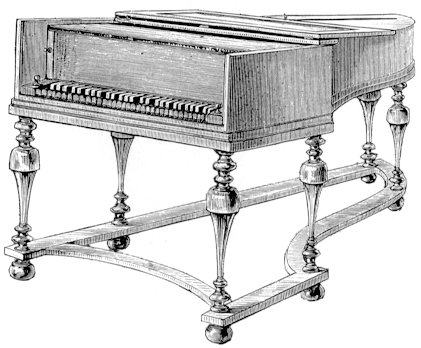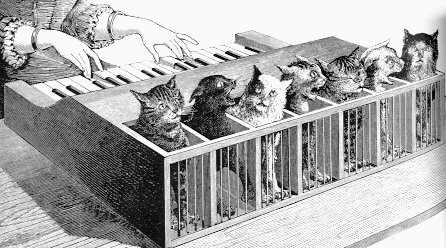Inventing the Piano
Today, a lesson in invention from the Far Side. The University of Houston's College of Engineering presents this series about the machines that make our civilization run, and the people whose ingenuity created them.
Do you know Gary Larson? He does those neat Far Side cartoons. Larson has a marvelous eye for dark absurdity: Two spiders have spun a web across the bottom of a child's slide. One says to the other, "If we pull this off, we'll eat like kings."
So I did a double take when I saw one about a caveman carving a piano out of a rock. A small side note said the piano was actually invented in 1709. That seemed far too early, but Larson has all the instincts of a scholar, and he's a good jazz musician to boot.
Anyone who listens to much classical music knows the early pianoforte was the instrument of Mozart, Haydn and Beethoven in the late 18th century. And the greatest harpsichord composer, Domenico Scarlatti, died in 1757 -- a half century after Larson's date. Still, if you can't trust Gary Larson, whom can you trust?
When I went looking, I found a surprising story about technological change. Starting in 1698, Bartolomeo Cristofori, keeper of the Medici musical instruments, began work on a machine that would combine features of the harpsichord and the clavichord.
When you press a harpsichord key, a mechanism plucks a string. Cristofori created a complex mechanism that would hammer the string instead, then damp the sound. That advantage would forever change the character of keyboard music. For now you could play both loudly and softly, depending on how you touched the key. Hence the new name pianoforte, which literally means soft and loud.
Cristofori's mechanism was a mechanical marvel. It all but eliminated any time delay in the hammers, and it kept the hammers from bouncing back to hit the string a second time. But his marvel didn't travel very far. And composers like Scarlatti kept right on writing for harpsichords.
European makers eventually began looking for a loud-soft keyboard instrument. When they did, they had to reinvent much of Cristofori's piano. Pianofortes didn't come into general use until composers felt the need for new and larger sounds. Mozart eventually wrote both for the new clarinet and for the new pianofortes. But that was long after Cristofori. Beethoven's music reflected the evolution of the piano into its near-modern form, with double and triple strings exerting eighteen-ton loads on massive steel frames.
The piano was thus invented and then laid aside until we were ready for its grander sound. Mozart may've contributed to the process when he pioneered the listener subscription concert. Music had to move out of Medici palaces into large public halls where a harpsichord is useless. Users are part of any invention, and it took them until the Industrial Revolution to lay claim on the modern industrial-strength piano that we all know.
So Gary Larson had it right. Now if someone could just tease Larson out of retirement so we could have Far Side cartoon commentary on our new 21st century!
I'm John Lienhard, at the University of Houston, where we're interested in the way inventive minds work.
(Theme music)
Larousse Encyclopedia of Music. (Geoffrey Hindley, ed.) New York: Crescent Books, 1971/1986. (See entry under "The pianoforte".)
(eight authors) Pianoforte. The New Grove Dictionary of Music and Musicians (Stanley Sadie, ed.). New York: MacMillan Publishers, Ltd., 1980, Vol. 14, pp. 682-714.

